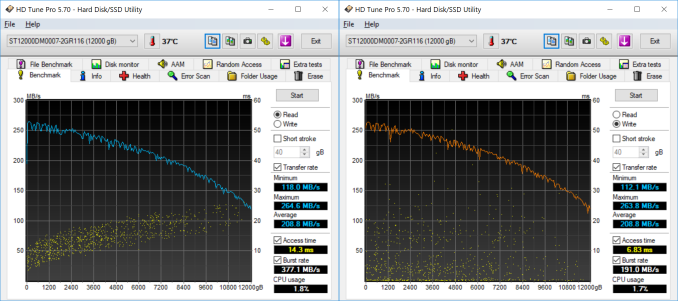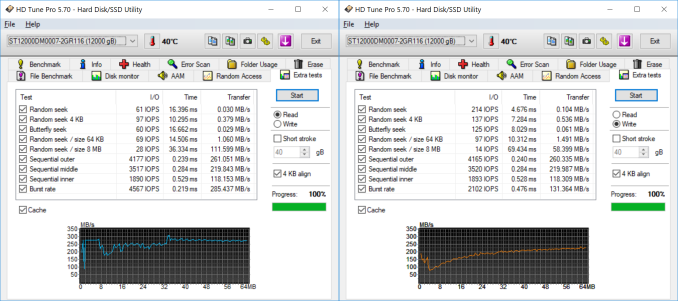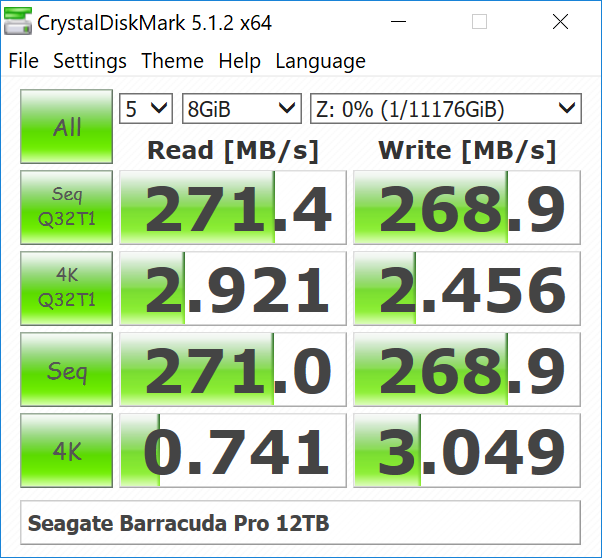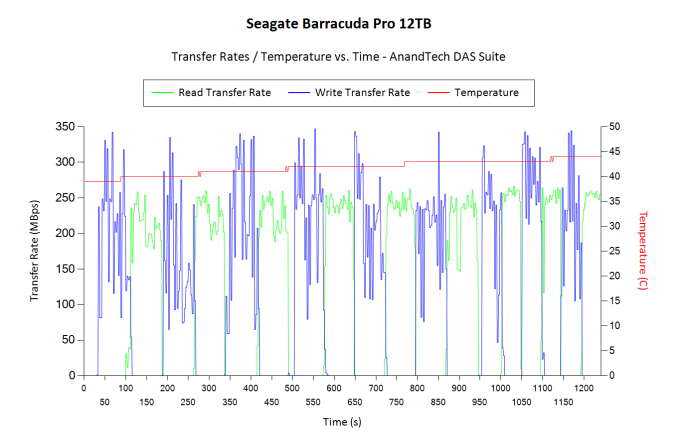Seagate BarraCuda Pro 12TB HDD Review
by Ganesh T S on November 15, 2017 8:00 AM EST- Posted in
- Storage
- Seagate
- HDDs
- Helium HDD
Performance - Internal Storage Mode
The performance of an internal storage device is dependent on the performance characteristics of the device as well as the file system being used. In order to isolate the effects of the latter, we first benchmarked the raw drives using HD Tune Pro 5.70. It was then formatted in NTFS and subject to our standard direct-attached benchmark suite.
Raw Drive Performance
HD Tune Pro allows us to run a variety of tests to determine transfer rates and IOPS for various artificial workloads. In addition, it also allows us to visualize how the performance varies as the tracking head moves from the outer parts of the platter towards the center (i.e, transfer rates as a function of the block address).
Empty drives are bound to perform very well, but, depending on the location of the data in the drive, we find that access rates can go as low as 112 MBps for sequential workloads. Write access times are a bit unpredictable due to the multi-segmented cache.
Random accesses are never the strong points of hard drives, and we see that the BarraCuda Pro delivers around 70 IOPS for 4K random reads and writes.
The extra tests help in putting some numbers to sequential accesses targeting different areas of the drive. It also provides some interesting numbers relevant to various random access workloads.
DAS Benchmarks
Consumers opting for drives such as the 12TB Seagate BarraCuda Pro typically need high-capacity local storage for holding and editing / processing large-sized multimedia files. Prior to taking a look at the real-life benchmarks, we first check what CrystalDiskMark has to report for the drive.
In order to tackle the real-life use-case of transferring large amounts of data back and forth from the drive, we created three test folders with the following characteristics:
- Photos: 15.6 GB collection of 4320 photos (RAW as well as JPEGs) in 61 sub-folders
- Videos: 16.1 GB collection of 244 videos (MP4 as well as MOVs) in 6 sub-folders
- BR: 10.7 GB Blu-ray folder structure of the IDT Benchmark Blu-ray (the same that we use in our robocopy tests for NAS systems)
| Seagate BarraCuda Pro 12TB robocopy Benchmarks (MBps) | ||
| Write Bandwidth | Read Bandwidth | |
| Photos | 219.23 | 205.51 |
| Videos | 231.42 | 219.46 |
| Blu-ray Folder | 234.05 | 230.02 |
These numbers are consistently around 15 - 20 MBps more than what we obtained for the 10TB drives last year.
While processing our DAS suite, we also recorded the instantaneous transfer rates and temperature of the drive. Compared to typical disk drives, the write transfers show higher instantaneous speeds due to a combination of the firmware and the 256 MB cache inside the drive. However, sustained write rates are comparable to other high-capacity drives when the cache is exhausted. The temperature of the unit at the end of the transfers (more than 250GB of traffic) rose by less than 5C, pointing to the power-efficiency of the platform.
For the use-case involving editing of multimedia files directly off the disk, we take advantage of PCMark 8's storage benchmark. The storage workload is a good example of a user workload, involving games as well as multimedia editing applications. The command line version allows us to cherry-pick storage traces to run on a target drive. We chose the following traces.
- Adobe Photoshop (Light)
- Adobe Photoshop (Heavy)
- Adobe After Effects
- Adobe Illustrator
Usually, PCMark 8 reports time to complete the trace, but the detailed log report has the read and write bandwidth figures which we present in our performance graphs. Note that the bandwidth number reported in the results don't involve idle time compression. Results might appear low, but that is part of the workload characteristic.
| Seagate BarraCuda Pro 12TB PCMark8 Storage Benchmarks (MBps) | ||
| Write Bandwidth | Read Bandwidth | |
| Adobe Photoshop (Light) | 250.22 | 9.06 |
| Adobe Photoshop (Heavy) | 246.88 | 11.48 |
| Adobe After Effects | 89.74 | 8.85 |
| Adobe Illustrator | 196.38 | 8.42 |
Compared to the results from the 10TB drive last year, we find that the read workloads are slightly worse off, but, the write workloads are much faster.















62 Comments
View All Comments
ddrіver - Wednesday, November 15, 2017 - link
"Conventional" magnetic recording is "giant magneto resistor recording". So what you're saying doesn't make sense.takeshi7 - Thursday, November 16, 2017 - link
It makes perfect sense. CMR is how hard drives have stored data on tracks since their inception in the 1950's. SMR is a different strategy for writing the tracks that has the writer overlap with previously written tracks to increase track density."Shingled" magnetic recording is also "giant magneto resistor recording". So that's not a good way to differentiate between them.
ddrіver - Thursday, November 16, 2017 - link
If CMR was the way HDDs worked from the inception then why would you call SMR anything other than that? They're all the same. Magnet. Poles. Everything else is buzzwords the industry is feeding you to make you buy more and more. And the sheeple buy.cm2187 - Wednesday, November 15, 2017 - link
Important question for usage in consumer NAS: how noisy is it?ganeshts - Wednesday, November 15, 2017 - link
All hard drives make noise - particularly if there are lots of random accesses making the heads move around a lot, and I don't think this was any more noisy than other disks that I have evaluated before. Spec sheets put it in the same category as everyone else - 28 dB typical / 30 dB max at idle, 32 dB typical / 34 dB max for performance seeks.To be honest, no one has brought up this aspect before, and I don't think
Ahnilated - Wednesday, November 15, 2017 - link
Do people still buy Seagate's stuff? Their HDD's have a notoriously high level of failure.coburn_c - Wednesday, November 15, 2017 - link
I don't think that's true anymore.haukionkannel - Wednesday, November 15, 2017 - link
Yep, that was a long time ago.Senti - Wednesday, November 15, 2017 - link
Nop, it's still very true. Seagate still holds undisputed first place on HDD failure %.CheapSushi - Thursday, November 16, 2017 - link
I believe that was just mainly for their 3TB or 4TB variants.